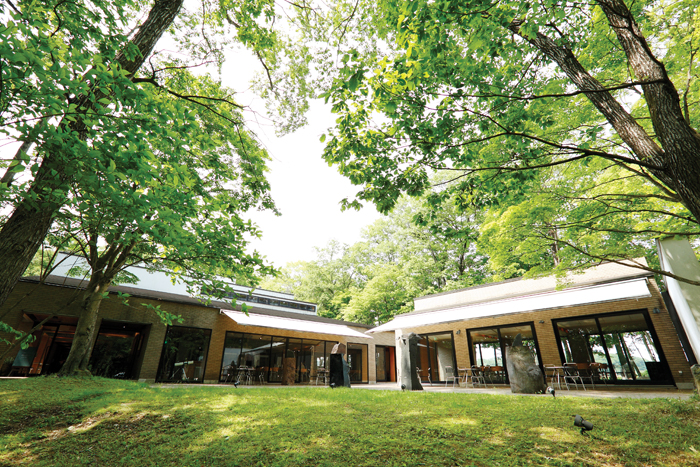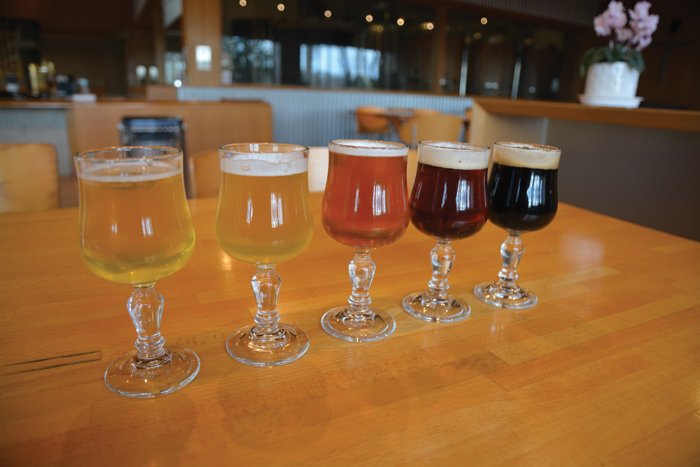Trivia question! The context: World Beer Cup, that competition where breweries get a little attention when they win. The Japanese brewery with the most medals is Swan Lake, at seven, followed by Hitachino Nest and Shonan Beer at six. After that, the brewery with five medals is? Yes, Fujizakura. Wait! They share that distinction with the brewery I’d like to talk about now, Nasu Kogen Beer, in the town of Nasu, Tochigi Prefecture. Between 2000 and 2008, Nasu Kogen Beer won twice for their stout and no less than three times for their Scottish Ale.
Oyamada Takashi, the president who leads Nasu Kogen Beer, was born into a family that ran a retail furniture-making business started by his grandfather. From an early age he would watch his grandfather work in the furniture factory until he eventually began to imitate him. It delighted him when his grandfather used an array of tools to make things for him by hand. That grandfather was one big man in the eyes of a little boy and the respect he commanded remains. When Oyamada’s father took over the family business, things began to change. The manufacture and sale of machinery for making furniture became a part of the business, and the family even expanded into furniture shops and franchising convenience stores.
Oyamada had been helping his father with the business expansion since graduating from university. Then in 1994, when he heard on the news that Prime Minister Hosokawa’s administration was going to deregulate the brewing laws to allow for microbreweries, his heart leapt. He recalls, “We were downsizing our furniture manufacturing business at that time and if anything, we were much more in the business of selling than making. But because of my grandfather’s influence I continued to want to do some kind of work where we made things. It was like that part of me lit with the flame of inspiration.”
Maybe because of global warming we don’t see this so much anymore, but Nasu’s Miyama Mountain used to be capped in snow well into summer. Oyamada, as early as elementary school, had precociously mused that the water from those melted snowcaps must be pretty good for making beer.
The rest of the family, however, including Oyamada’s father, was vehemently opposed to going into the beer business. To try to convince his father he took him on a brewery tour of Okhotsk Beer, which opened in 1995. Alas, the moment they left the brewery, his father said, “Don’t you see that it’s going to be a little too hard for us to do something like this?” Oyamada confesses, “My dad didn’t know much at all about making beer or selling it, but he had a lot of experience in business and a propensity for seeing things like they were.”
Refusing to give up, Oyamada traveled to the nearby Utsunomiya tax office to determine the steps necessary for obtaining a brewery license. At first they told him, “Most of the licenses are going to companies that have been brewing sake. We just don’t see how someone in a completely different field like furniture making can do it, sorry.” He then got his hands on a book detailing the steps for obtaining a brewery license. After immersing himself in that, he filed his application forms and finally got his license in September of 1996.
“At that time I was running five different business ventures so I thought that adding another wouldn’t make that big a difference, but that was ridiculously naïve,” Oyamada reflects. Until then the businesses that he was involved in were mainly small retail, but producing something from scratch posed challenges of a whole different nature.
To learn more about brewing techniques he sent two people to Hungary for training: Fujita Masafumi, who is still the brewmaster, and Noda Ryohei. Oyamada himself went to Germany and visited some thirty breweries. He laughs, “I was drinking about two or three liters of beer every day. Sometimes I was really hungover, sometimes I wasn’t. One day, I was guzzling some unfiltered beer and woke up the next morning feeling fine. I decided then and there I was going to make unfiltered beer.” This is of course Oyamada’s personal experience. Please be advised that not everyone will enjoy the same outcome when guzzling unfiltered beer.
Echigo Beer’s original brewer, Bawa Demuyakor, additionally visited Oyamada’s brewery to provide training, having launched his own yeast retail business when he left Echigo. In his native Ghana he had worked in a Guinness factory and later attended Hiroshima University where he received a PhD in yeast science before joining Echigo.
“Bawa’s research, not to mention his experience at Guinness and Echigo, was impressive, but more than anything, he was just a great guy. I had no experience at the time and he didn’t just help me with the brewing; he actually washed the equipment with me. And he did it with such a smile on his face.” Apparently, he was also uncommonly good at teaching important points about brewing. Thereafter, whenever Oyamada planned to release a new beer, he would absolutely consult with Bawa, who would accompany him on the first brew. “The beer that I made with Bawa was exceptionally delicious. He was a whole different level.”
While continuing to receive guidance from Bawa, Nasu Kogen Beer started off with the following line-up: pilsner, weizen, English ale (a British pale ale by style), Scottish ale and stout (a foreign stout by style). For a while after opening, they would sometimes switch the stout out for a doppelbock.
The reason for this lineup was that Oyamada wanted to show people that different regions can have particular beer styles. For example, Scottish ale (which is rarely brewed in Japan) falls between an English ale and stout in terms of color. He could demonstrate the diversity of color in beer as well as the diversity of a region like Scotland that seemingly manifests itself in the beer’s unique character. It may simply look like a marketing ploy, but the quality, as mentioned before, was worthy of World Beer Cup medals and other international awards.
In the winter, the brewery also serves the stout warm. When you compare it to the stout at slightly less than room temperature, the bitterness is more subdued, but the aroma and sweetness is more pronounced. Add a cinnamon stick to it and you have yet another way to enjoy it.
In 1998 Oyamada began producing the beer many people associate with the brewery: Nine-Tailed Fox. Style guidelines generally classify it as a barley wine and most consumers tend to agree with that assessment. I thought the same, but Oyamada explains, “I developed that because I wanted to open up a new beer style called ‘Vintage Beer.’ The difference with a barley wine is, hmm… let’s just say that the yeast is not an ale yeast and leave it at that.” The true character of this Nine-Tailed Fox, which has a potency that can lay people flat, remains a mystery.
Nasu Kogen brews this beer every summer and stores versions going back to 1998. The year 2018, when some people may be able to enjoy the 20-year-aged bottles, doesn’t seem too far off. Oyamada, though, has his sights set on 100-year bottles. While I unfortunately won’t be around to enjoy those bottles, when I think of craft beer in Japan one hundred years from now, I feel like the possibilities are limitless and as bewitching as a fox in Japanese folklore.
A large bottle brewed as recently as 2014 goes for ¥3780, with the prices going up ¥540 for each year that they are cellared. The oldest bottles from 1998 now go for ¥12,420. At first everyone just complained that they were too expensive but after about a decade of the practice, people finally began to realize that the flavors mellowed and became only more delicious with age.
The aroma is a complex bouquet of malt, fruit and hop all at once. The strength and sharpness of the alcohol certainly comes through, too. As the beer ages, it continues to mature. At the brewery restaurant, it is served with fresh chocolate made with their stout. The sweetness of the chocolate helps temper the sharpness of the alcohol and the bitterness of the hops, making it devilishly easy to drink.
In 2003 they launched “Ai” (love). In terms of style it is a Münchner Helles, but definitely on the milder side. The brewery named it after the birth of Aiko, daughter to the Crown Prince and Princess of Japan. The label even features a white azalea, which is Aiko’s seal. As many may know, there is an imperial villa in the Nasu Kogen area and the imperial family often visits the town in the summer.
After the beer had gone on sale, they received an order from the Imperial Household Agency. The Crown Prince apparently said that he wanted to use Ai for the toast at the beginning of a national farmers conference being held in Nasu Kogen. Apparently, the Crown Prince and Princess had said, “Please tell them the beer was delicious.” Such was the communication that the agency delivered.
Beyond the 100-year vintage beer, another idea that Oyamada has considered is naming a beer after Bawa. “Before Bawa returned to Ghana, he said, ‘I’ve passed on all my knowledge of brewing to Nasu Kogen.’ I want to express our deep gratitude to him through beer.”
The bullet train from Tokyo to the station closest to the brewery, Nasu Shiobara, takes about eighty minutes. A visit to Nasu Kogen Beer naturally goes hand in hand with a visit to the resort area in spring and summer, or to the hot springs in winter. You might even consider traveling to the Nine-Tailed Fox Party that’s held every autumn. The participation fee is a little pricey but seems worth it when you consider that guests will be able to enjoy multiple vintage years of the Nine-Tailed Fox. In addition to the brewery restaurant, the brewpub Blue Magic in nearby Utsunomiya City also serves several of Nasu Kogen’s beers. Grabbing a plate of gyoza there will only add to the experience.
Kumagai Jinya
This article was published in Japan Beer Times # () and is among the limited content available online. Order your copy through our online shop or download the digital version from the iTunes store to access the full contents of this issue.







